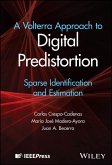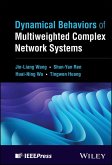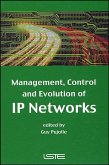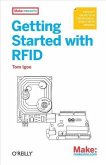Carlos Crespo-Cadenas, Maria Jose Madero-Ayora, Juan A. Becerra
A Volterra Approach to Digital Predistortion (eBook, PDF)
Sparse Identification and Estimation
108,99 €
108,99 €
inkl. MwSt.
Sofort per Download lieferbar

0 °P sammeln
108,99 €
Als Download kaufen

108,99 €
inkl. MwSt.
Sofort per Download lieferbar

0 °P sammeln
Jetzt verschenken
Alle Infos zum eBook verschenken
108,99 €
inkl. MwSt.
Sofort per Download lieferbar
Alle Infos zum eBook verschenken

0 °P sammeln
Carlos Crespo-Cadenas, Maria Jose Madero-Ayora, Juan A. Becerra
A Volterra Approach to Digital Predistortion (eBook, PDF)
Sparse Identification and Estimation
- Format: PDF
- Merkliste
- Auf die Merkliste
- Bewerten Bewerten
- Teilen
- Produkt teilen
- Produkterinnerung
- Produkterinnerung

Bitte loggen Sie sich zunächst in Ihr Kundenkonto ein oder registrieren Sie sich bei
bücher.de, um das eBook-Abo tolino select nutzen zu können.
Hier können Sie sich einloggen
Hier können Sie sich einloggen
Sie sind bereits eingeloggt. Klicken Sie auf 2. tolino select Abo, um fortzufahren.

Bitte loggen Sie sich zunächst in Ihr Kundenkonto ein oder registrieren Sie sich bei bücher.de, um das eBook-Abo tolino select nutzen zu können.
Thorough discussion of the theory and application of the Volterra series for impairments compensation in RF circuits and systems
A Volterra Approach to Digital Predistortion: Sparse Identification and Estimation offers a comprehensive treatment of the Volterra series approach as a practical tool for the behavioral modeling and linearization of nonlinear wireless communication systems. Although several perspectives can be considered when analyzing nonlinear effects, this book focuses on the Volterra series to study systems with real-valued continuous time RF signals as well as complex-valued…mehr
- Geräte: PC
- mit Kopierschutz
- eBook Hilfe
- Größe: 9.78MB
Andere Kunden interessierten sich auch für
![A Volterra Approach to Digital Predistortion (eBook, ePUB) A Volterra Approach to Digital Predistortion (eBook, ePUB)]() Carlos Crespo-CadenasA Volterra Approach to Digital Predistortion (eBook, ePUB)108,99 €
Carlos Crespo-CadenasA Volterra Approach to Digital Predistortion (eBook, ePUB)108,99 €![Mobile Communication Systems for Private Networks (eBook, PDF) Mobile Communication Systems for Private Networks (eBook, PDF)]() Srinivasan BalasubramanianMobile Communication Systems for Private Networks (eBook, PDF)107,99 €
Srinivasan BalasubramanianMobile Communication Systems for Private Networks (eBook, PDF)107,99 €![Dynamical Behaviors of Multiweighted Complex Network Systems (eBook, PDF) Dynamical Behaviors of Multiweighted Complex Network Systems (eBook, PDF)]() Jin-Liang WangDynamical Behaviors of Multiweighted Complex Network Systems (eBook, PDF)103,99 €
Jin-Liang WangDynamical Behaviors of Multiweighted Complex Network Systems (eBook, PDF)103,99 €![IP over WDM (eBook, PDF) IP over WDM (eBook, PDF)]() Kevin H. LiuIP over WDM (eBook, PDF)107,99 €
Kevin H. LiuIP over WDM (eBook, PDF)107,99 €![Beyond VoIP Protocols (eBook, PDF) Beyond VoIP Protocols (eBook, PDF)]() Olivier HersentBeyond VoIP Protocols (eBook, PDF)76,99 €
Olivier HersentBeyond VoIP Protocols (eBook, PDF)76,99 €![Management, Control and Evolution of IP Networks (eBook, PDF) Management, Control and Evolution of IP Networks (eBook, PDF)]() Management, Control and Evolution of IP Networks (eBook, PDF)318,99 €
Management, Control and Evolution of IP Networks (eBook, PDF)318,99 €![Getting Started with RFID (eBook, PDF) Getting Started with RFID (eBook, PDF)]() Tom IgoeGetting Started with RFID (eBook, PDF)3,99 €
Tom IgoeGetting Started with RFID (eBook, PDF)3,99 €-
-
-
Thorough discussion of the theory and application of the Volterra series for impairments compensation in RF circuits and systems
A Volterra Approach to Digital Predistortion: Sparse Identification and Estimation offers a comprehensive treatment of the Volterra series approach as a practical tool for the behavioral modeling and linearization of nonlinear wireless communication systems. Although several perspectives can be considered when analyzing nonlinear effects, this book focuses on the Volterra series to study systems with real-valued continuous time RF signals as well as complex-valued discrete-time baseband signals in the digital signal processing field.
A unified framework provides the reader with in-depth understanding of the available Volterra-based behavioral models; in particular, the book emphasizes those models derived by exploiting the knowledge of the physical phenomena that produce different types of nonlinear distortion. From these distinctive standpoints, this work remarkably contributes to theoretical issues of behavioral modeling.
The book contributes to practical state-of-the-art questions on linearization, granting the reader practical guidance in designing digital predistortion schemes and adopting up-to-date machine learning methods to exploit the sparsity of the identification problem and reducing computational complexity.
Later chapters include information on:
A Volterra Approach to Digital Predistortion: Sparse Identification and Estimation is an essential reference on the subject for engineers and technicians who develop new products for the linearization of wireless transmitters, as well as researchers and students in fields and programs of study related to wireless communications.
A Volterra Approach to Digital Predistortion: Sparse Identification and Estimation offers a comprehensive treatment of the Volterra series approach as a practical tool for the behavioral modeling and linearization of nonlinear wireless communication systems. Although several perspectives can be considered when analyzing nonlinear effects, this book focuses on the Volterra series to study systems with real-valued continuous time RF signals as well as complex-valued discrete-time baseband signals in the digital signal processing field.
A unified framework provides the reader with in-depth understanding of the available Volterra-based behavioral models; in particular, the book emphasizes those models derived by exploiting the knowledge of the physical phenomena that produce different types of nonlinear distortion. From these distinctive standpoints, this work remarkably contributes to theoretical issues of behavioral modeling.
The book contributes to practical state-of-the-art questions on linearization, granting the reader practical guidance in designing digital predistortion schemes and adopting up-to-date machine learning methods to exploit the sparsity of the identification problem and reducing computational complexity.
Later chapters include information on:
- Identification of Volterra-based models as a linear regression problem, allowing the adoption of sparse machine learning methods to reduce computational complexity while keeping rich model structures
- Deduction of Volterra models based on circuit model knowledge, offering pruned model structures that are better fitted for specific scenarios
- Wireless communication systems and the nonlinear effects produced by power amplifiers, mixers, frequency converters or IQ modulators
- Digital predistortion schemes and experimental results for both indirect and direct learning architectures
A Volterra Approach to Digital Predistortion: Sparse Identification and Estimation is an essential reference on the subject for engineers and technicians who develop new products for the linearization of wireless transmitters, as well as researchers and students in fields and programs of study related to wireless communications.
Dieser Download kann aus rechtlichen Gründen nur mit Rechnungsadresse in D ausgeliefert werden.
Produktdetails
- Produktdetails
- Verlag: John Wiley & Sons
- Seitenzahl: 274
- Erscheinungstermin: 18. Dezember 2024
- Englisch
- ISBN-13: 9781394248148
- Artikelnr.: 72643501
- Verlag: John Wiley & Sons
- Seitenzahl: 274
- Erscheinungstermin: 18. Dezember 2024
- Englisch
- ISBN-13: 9781394248148
- Artikelnr.: 72643501
- Herstellerkennzeichnung Die Herstellerinformationen sind derzeit nicht verfügbar.
Carlos Crespo-Cadenas, PhD, is a Full Professor at the Universidad de Sevilla, Spain.
María José Madero-Ayora, PhD, is an Associate Professor at the Universidad de Sevilla, Spain.
Juan A. Becerra, PhD, is an Associate Professor at the Universidad de Sevilla, Spain.
The authors are members of IEEE and the Microwave Theory and Techniques (MTT) Society and have published over 70 papers and served as reviewers for several research journals and international conferences.
María José Madero-Ayora, PhD, is an Associate Professor at the Universidad de Sevilla, Spain.
Juan A. Becerra, PhD, is an Associate Professor at the Universidad de Sevilla, Spain.
The authors are members of IEEE and the Microwave Theory and Techniques (MTT) Society and have published over 70 papers and served as reviewers for several research journals and international conferences.
About the Authors xiii
Preface xv
Acknowledgments xvii
Notation Conventions xviii
Acronyms xx
1 Overview of Nonlinear Effects in Wireless Communication Systems 1
1.1 Wireless Communication Systems 1
1.1.1 Transmitters and Receivers 1
1.1.2 Real-valued Continuous-time RF Signals and Complex-valued
Discrete-time Baseband Signals 3
1.2 Modeling Power Amplifiers 6
1.3 Modeling Mixers and Modulators 10
1.4 Circuit Models of Nonlinear Devices 14
1.4.1 Nonlinear Circuit Elements Representation 14
1.4.2 Large-signal Models for FET Devices 16
1.4.2.1 Angelov Model for the Drain Current Characteristics 17
1.4.2.2 Models for the Gate Capacitances 18
1.4.2.3 Simplified Nonlinear Models for FET Amplifiers 18
1.5 Experimental Evaluation of Nonlinear Circuits: Classical Methods 20
1.5.1 One-tone Characterization Tests 20
1.5.1.1 Implementation of One-tone Tests 22
1.5.2 Two-tone Characterization Tests 23
1.5.2.1 In-band Intermodulation Distortion 23
1.5.2.2 Out-of-band Components 26
1.5.2.3 Implementation of Two-tone Tests 26
1.5.3 Memory Effects 28
1.6 Behavioral Modeling and Linearization of Nonlinear Systems 33
1.6.1 Harmonic Balance 33
1.6.2 Volterra Series 34
1.6.3 Neural Networks 38
1.7 Regression 40
1.8 Structure of the Book 41
Bibliography 43
2 Volterra Series Approach 49
2.1 Introduction 49
2.2 Volterra Series 50
2.2.1 Properties of the Volterra Series 52
2.2.1.1 Convergence 52
2.2.1.2 Homogeneous Nonlinear Systems 54
2.2.1.3 Linearity in Nonlinear Systems 54
2.2.1.4 Memory and Memoryless Systems 54
2.2.1.5 Volterra Series for Complex-valued Systems 55
2.3 Volterra Series Applied to RF Amplifier Modeling 55
2.3.1 Response of an Amplifier to a Single Sine Wave 56
2.3.1.1 Volterra-based, Yet Simple, Analysis of Conventional Amplifier
Modes 59
2.3.1.2 Class-A Mode 60
2.3.1.3 Class-B Mode 61
2.3.2 Determining Nonlinear Transfer Functions 62
2.3.2.1 Nonlinear Currents Method 62
2.3.2.2 Harmonic Input Method 65
2.4 Volterra Series in the Frequency Domain 69
2.5 Two-block Models: Wiener and Hammerstein 72
2.6 Double Volterra Series 74
2.6.1 The Double Volterra Series in the Analysis of Mixers 76
2.6.1.1 FET Resistive Mixer 78
2.7 Analysis of Intermodulation Distortion 80
2.7.1 Example of Volterra IMD Analysis in FET Amplifiers 80
2.8 Baseband Volterra Model 84
Bibliography 87
3 Discrete-time Volterra Models 91
3.1 Introduction 91
3.2 Discrete-time Volterra Models for Power Amplifiers 93
3.2.1 Volterra Models for Real-valued Systems 93
3.2.2 The Equivalent Baseband Volterra Model 95
3.2.3 Multidimensional Signal Processing 96
3.2.3.1 Frequency-domain Characterization of Discrete Signals and Systems
97
3.3 Reducing the Volterra Model Complexity 99
3.3.1 Need for Model Pruning 99
3.3.2 Heuristic Reduction of the Volterra Model Complexity 100
3.3.2.1 The Univariate Zero-memory Volterra Model 100
3.3.2.2 The Univariate Memory Polynomial Model 101
3.3.2.3 The Univariate Generalized Memory Polynomial Model 102
3.4 Discrete-time Double Volterra Model 102
3.4.1 Double Volterra Model Properties 104
3.5 Volterra-Parafac Model 104
3.5.1 Basis of Tensor Algebra 105
3.5.1.1 Special Forms of Tensors 105
3.5.2 Baseband Volterra-Parafac Model 106
3.6 Volterra Models in the Frequency Domain 109
3.6.1 The Baseband Volterra Model in the Frequency Domain 111
3.6.2 Volterra-Parafac Models in the Frequency Domain 113
3.6.3 Application of a Frequency Domain MP Model to Linearization in OFDM
Transmissions 115
3.7 Complex-valued Volterra Model 116
3.8 Figures of Merit for Experimental Methods in Modeling and Linearization
119
3.8.1 Normalized Mean Squared Error 121
3.8.2 Adjacent Channel Power Ratio 122
3.8.3 Noise Power Ratio 123
3.8.4 Adjacent Channel Error Power Ratio 124
3.8.5 Error Vector Magnitude 125
Bibliography 125
4 Volterra Models Pruning Based on Circuit Knowledge 129
4.1 Introduction 129
4.2 Heuristic Pruning of Volterra Models 130
4.2.1 Memory Polynomial (MP) Model 130
4.2.2 Generalized Memory Polynomial (GMP) Model 131
4.2.3 Dynamic Deviation Reduction (DDR) Model 131
4.2.4 Other Heuristic Pruning Proposals 132
4.3 Pruning Based on Equivalent Circuit Knowledge 132
4.3.1 Structure of the Kernels 133
4.3.1.1 First-Order Kernel 134
4.3.1.2 Third-Order Kernel 134
4.3.1.3 Fifth-Order Kernel 136
4.3.2 Volterra Behavioral Model for Wideband Amplifiers 137
4.3.2.1 Extension of the VBW 137
4.4 Circuit Knowledge Model with Electrothermal Effects 141
4.4.1 Third-Order Kernel 143
4.4.2 Fifth-Order Kernel 145
4.5 Circuit Knowledge in Bivariate Volterra Models 146
4.5.1 The Bivariate FV Model 148
4.5.2 The Bivariate-CKV Model 148
4.5.3 Model for Concurrent Dual-Band Signal 149
4.6 Volterra Models for I/Q Modulators 151
4.6.1 Two-Tone Test for I/Q Modulators 151
4.6.2 Widely Nonlinear Approach for I/Q Modulators 155
4.6.2.1 Analysis of the I Branch 156
4.6.2.2 Analysis of the Q Branch 156
4.6.2.3 Discrete-Time Baseband Model of the I/Q Modulator 156
4.6.2.4 Model Structure of a Transmitter in the Presence of I/Q Impairments
157
Bibliography 159
5 Regression of Volterra Models 163
5.1 Introduction 163
5.2 Least Squares Algorithm 164
5.2.1 The Measurement Equation 164
5.2.2 The Least Squares Method 166
5.2.3 The Autocorrelation and Crossvariance Matrices 168
5.2.3.1 Autocovariance Matrix 168
5.2.3.2 Definition of Least Squares (LS) in Terms of the Crosscorrelation
and Crossvariance Matrices 169
5.2.4 Centering, Normalization, and Standardization 170
5.2.5 Performance Indicators 171
5.2.6 A Practical Regression 172
5.3 Regularization 175
5.3.1 Ridge Regression (l 2 -Norm Minimization) 176
5.3.2 LASSO (l 1 -Norm Minimization) 177
5.4 Adaptive Optimization and Iterative Regression 179
5.4.1 Steepest Descent 179
5.4.2 The Least Mean Squares (LMS) Algorithm 180
Bibliography 181
6 Sparse Machine Learning 183
6.1 Introduction 183
6.2 Thresholding 184
6.3 Local Search: Hill Climbing 185
6.4 Greedy Pursuits 185
6.4.1 Orthogonal Matching Pursuit (OMP) 186
6.4.2 Principal Component Analysis (PCA) 187
6.4.3 Doubly Orthogonal Matching Pursuit (DOMP) 189
6.5 Stopping Criteria 191
6.5.1 Custom Target 191
6.5.2 Bayesian Information Criterion 192
6.6 Sparse Bayesian Learning 193
6.6.1 Sparse Bayesian Pursuit (SBP) 196
6.6.2 Deselecting Regressors 199
6.6.2.1 Reconfiguring an Amplifier Model 200
6.6.3 Bayesian Upgrading 202
6.6.3.1 SBL Comparison to Other Techniques 203
6.6.3.2 Two Cases of Model Upgrading 203
6.7 A Practical Sparse Regression 204
Bibliography 208
7 Transmitter Linearization with Digital Predistorters 211
7.1 Introduction 211
7.2 Digital Predistortion 212
7.3 Indirect Learning Architecture 213
7.4 Direct Learning Architecture 214
7.5 Some Practical Digital Predistortion Results 216
7.5.1 Case 1: Basic Digital Predistorter with Indirect Learning
Architecture 217
7.5.2 Case 2: Digital Predistorter with Coefficients Selection and Indirect
Learning Architecture 220
7.5.3 Case 3: Linearization for an Input Power Sweep with Indirect Learning
Architecture 226
7.5.4 Case 4: Basic Digital Predistorter with Direct Learning Architecture
229
7.5.5 Case 5: Digital Predistorter with Coefficients Selection and Direct
Learning Architecture 232
7.5.6 Case 6: Linearization for an Input Power Sweep with Direct Learning
Architecture 235
Bibliography 239
Index 243
Preface xv
Acknowledgments xvii
Notation Conventions xviii
Acronyms xx
1 Overview of Nonlinear Effects in Wireless Communication Systems 1
1.1 Wireless Communication Systems 1
1.1.1 Transmitters and Receivers 1
1.1.2 Real-valued Continuous-time RF Signals and Complex-valued
Discrete-time Baseband Signals 3
1.2 Modeling Power Amplifiers 6
1.3 Modeling Mixers and Modulators 10
1.4 Circuit Models of Nonlinear Devices 14
1.4.1 Nonlinear Circuit Elements Representation 14
1.4.2 Large-signal Models for FET Devices 16
1.4.2.1 Angelov Model for the Drain Current Characteristics 17
1.4.2.2 Models for the Gate Capacitances 18
1.4.2.3 Simplified Nonlinear Models for FET Amplifiers 18
1.5 Experimental Evaluation of Nonlinear Circuits: Classical Methods 20
1.5.1 One-tone Characterization Tests 20
1.5.1.1 Implementation of One-tone Tests 22
1.5.2 Two-tone Characterization Tests 23
1.5.2.1 In-band Intermodulation Distortion 23
1.5.2.2 Out-of-band Components 26
1.5.2.3 Implementation of Two-tone Tests 26
1.5.3 Memory Effects 28
1.6 Behavioral Modeling and Linearization of Nonlinear Systems 33
1.6.1 Harmonic Balance 33
1.6.2 Volterra Series 34
1.6.3 Neural Networks 38
1.7 Regression 40
1.8 Structure of the Book 41
Bibliography 43
2 Volterra Series Approach 49
2.1 Introduction 49
2.2 Volterra Series 50
2.2.1 Properties of the Volterra Series 52
2.2.1.1 Convergence 52
2.2.1.2 Homogeneous Nonlinear Systems 54
2.2.1.3 Linearity in Nonlinear Systems 54
2.2.1.4 Memory and Memoryless Systems 54
2.2.1.5 Volterra Series for Complex-valued Systems 55
2.3 Volterra Series Applied to RF Amplifier Modeling 55
2.3.1 Response of an Amplifier to a Single Sine Wave 56
2.3.1.1 Volterra-based, Yet Simple, Analysis of Conventional Amplifier
Modes 59
2.3.1.2 Class-A Mode 60
2.3.1.3 Class-B Mode 61
2.3.2 Determining Nonlinear Transfer Functions 62
2.3.2.1 Nonlinear Currents Method 62
2.3.2.2 Harmonic Input Method 65
2.4 Volterra Series in the Frequency Domain 69
2.5 Two-block Models: Wiener and Hammerstein 72
2.6 Double Volterra Series 74
2.6.1 The Double Volterra Series in the Analysis of Mixers 76
2.6.1.1 FET Resistive Mixer 78
2.7 Analysis of Intermodulation Distortion 80
2.7.1 Example of Volterra IMD Analysis in FET Amplifiers 80
2.8 Baseband Volterra Model 84
Bibliography 87
3 Discrete-time Volterra Models 91
3.1 Introduction 91
3.2 Discrete-time Volterra Models for Power Amplifiers 93
3.2.1 Volterra Models for Real-valued Systems 93
3.2.2 The Equivalent Baseband Volterra Model 95
3.2.3 Multidimensional Signal Processing 96
3.2.3.1 Frequency-domain Characterization of Discrete Signals and Systems
97
3.3 Reducing the Volterra Model Complexity 99
3.3.1 Need for Model Pruning 99
3.3.2 Heuristic Reduction of the Volterra Model Complexity 100
3.3.2.1 The Univariate Zero-memory Volterra Model 100
3.3.2.2 The Univariate Memory Polynomial Model 101
3.3.2.3 The Univariate Generalized Memory Polynomial Model 102
3.4 Discrete-time Double Volterra Model 102
3.4.1 Double Volterra Model Properties 104
3.5 Volterra-Parafac Model 104
3.5.1 Basis of Tensor Algebra 105
3.5.1.1 Special Forms of Tensors 105
3.5.2 Baseband Volterra-Parafac Model 106
3.6 Volterra Models in the Frequency Domain 109
3.6.1 The Baseband Volterra Model in the Frequency Domain 111
3.6.2 Volterra-Parafac Models in the Frequency Domain 113
3.6.3 Application of a Frequency Domain MP Model to Linearization in OFDM
Transmissions 115
3.7 Complex-valued Volterra Model 116
3.8 Figures of Merit for Experimental Methods in Modeling and Linearization
119
3.8.1 Normalized Mean Squared Error 121
3.8.2 Adjacent Channel Power Ratio 122
3.8.3 Noise Power Ratio 123
3.8.4 Adjacent Channel Error Power Ratio 124
3.8.5 Error Vector Magnitude 125
Bibliography 125
4 Volterra Models Pruning Based on Circuit Knowledge 129
4.1 Introduction 129
4.2 Heuristic Pruning of Volterra Models 130
4.2.1 Memory Polynomial (MP) Model 130
4.2.2 Generalized Memory Polynomial (GMP) Model 131
4.2.3 Dynamic Deviation Reduction (DDR) Model 131
4.2.4 Other Heuristic Pruning Proposals 132
4.3 Pruning Based on Equivalent Circuit Knowledge 132
4.3.1 Structure of the Kernels 133
4.3.1.1 First-Order Kernel 134
4.3.1.2 Third-Order Kernel 134
4.3.1.3 Fifth-Order Kernel 136
4.3.2 Volterra Behavioral Model for Wideband Amplifiers 137
4.3.2.1 Extension of the VBW 137
4.4 Circuit Knowledge Model with Electrothermal Effects 141
4.4.1 Third-Order Kernel 143
4.4.2 Fifth-Order Kernel 145
4.5 Circuit Knowledge in Bivariate Volterra Models 146
4.5.1 The Bivariate FV Model 148
4.5.2 The Bivariate-CKV Model 148
4.5.3 Model for Concurrent Dual-Band Signal 149
4.6 Volterra Models for I/Q Modulators 151
4.6.1 Two-Tone Test for I/Q Modulators 151
4.6.2 Widely Nonlinear Approach for I/Q Modulators 155
4.6.2.1 Analysis of the I Branch 156
4.6.2.2 Analysis of the Q Branch 156
4.6.2.3 Discrete-Time Baseband Model of the I/Q Modulator 156
4.6.2.4 Model Structure of a Transmitter in the Presence of I/Q Impairments
157
Bibliography 159
5 Regression of Volterra Models 163
5.1 Introduction 163
5.2 Least Squares Algorithm 164
5.2.1 The Measurement Equation 164
5.2.2 The Least Squares Method 166
5.2.3 The Autocorrelation and Crossvariance Matrices 168
5.2.3.1 Autocovariance Matrix 168
5.2.3.2 Definition of Least Squares (LS) in Terms of the Crosscorrelation
and Crossvariance Matrices 169
5.2.4 Centering, Normalization, and Standardization 170
5.2.5 Performance Indicators 171
5.2.6 A Practical Regression 172
5.3 Regularization 175
5.3.1 Ridge Regression (l 2 -Norm Minimization) 176
5.3.2 LASSO (l 1 -Norm Minimization) 177
5.4 Adaptive Optimization and Iterative Regression 179
5.4.1 Steepest Descent 179
5.4.2 The Least Mean Squares (LMS) Algorithm 180
Bibliography 181
6 Sparse Machine Learning 183
6.1 Introduction 183
6.2 Thresholding 184
6.3 Local Search: Hill Climbing 185
6.4 Greedy Pursuits 185
6.4.1 Orthogonal Matching Pursuit (OMP) 186
6.4.2 Principal Component Analysis (PCA) 187
6.4.3 Doubly Orthogonal Matching Pursuit (DOMP) 189
6.5 Stopping Criteria 191
6.5.1 Custom Target 191
6.5.2 Bayesian Information Criterion 192
6.6 Sparse Bayesian Learning 193
6.6.1 Sparse Bayesian Pursuit (SBP) 196
6.6.2 Deselecting Regressors 199
6.6.2.1 Reconfiguring an Amplifier Model 200
6.6.3 Bayesian Upgrading 202
6.6.3.1 SBL Comparison to Other Techniques 203
6.6.3.2 Two Cases of Model Upgrading 203
6.7 A Practical Sparse Regression 204
Bibliography 208
7 Transmitter Linearization with Digital Predistorters 211
7.1 Introduction 211
7.2 Digital Predistortion 212
7.3 Indirect Learning Architecture 213
7.4 Direct Learning Architecture 214
7.5 Some Practical Digital Predistortion Results 216
7.5.1 Case 1: Basic Digital Predistorter with Indirect Learning
Architecture 217
7.5.2 Case 2: Digital Predistorter with Coefficients Selection and Indirect
Learning Architecture 220
7.5.3 Case 3: Linearization for an Input Power Sweep with Indirect Learning
Architecture 226
7.5.4 Case 4: Basic Digital Predistorter with Direct Learning Architecture
229
7.5.5 Case 5: Digital Predistorter with Coefficients Selection and Direct
Learning Architecture 232
7.5.6 Case 6: Linearization for an Input Power Sweep with Direct Learning
Architecture 235
Bibliography 239
Index 243
About the Authors xiii
Preface xv
Acknowledgments xvii
Notation Conventions xviii
Acronyms xx
1 Overview of Nonlinear Effects in Wireless Communication Systems 1
1.1 Wireless Communication Systems 1
1.1.1 Transmitters and Receivers 1
1.1.2 Real-valued Continuous-time RF Signals and Complex-valued
Discrete-time Baseband Signals 3
1.2 Modeling Power Amplifiers 6
1.3 Modeling Mixers and Modulators 10
1.4 Circuit Models of Nonlinear Devices 14
1.4.1 Nonlinear Circuit Elements Representation 14
1.4.2 Large-signal Models for FET Devices 16
1.4.2.1 Angelov Model for the Drain Current Characteristics 17
1.4.2.2 Models for the Gate Capacitances 18
1.4.2.3 Simplified Nonlinear Models for FET Amplifiers 18
1.5 Experimental Evaluation of Nonlinear Circuits: Classical Methods 20
1.5.1 One-tone Characterization Tests 20
1.5.1.1 Implementation of One-tone Tests 22
1.5.2 Two-tone Characterization Tests 23
1.5.2.1 In-band Intermodulation Distortion 23
1.5.2.2 Out-of-band Components 26
1.5.2.3 Implementation of Two-tone Tests 26
1.5.3 Memory Effects 28
1.6 Behavioral Modeling and Linearization of Nonlinear Systems 33
1.6.1 Harmonic Balance 33
1.6.2 Volterra Series 34
1.6.3 Neural Networks 38
1.7 Regression 40
1.8 Structure of the Book 41
Bibliography 43
2 Volterra Series Approach 49
2.1 Introduction 49
2.2 Volterra Series 50
2.2.1 Properties of the Volterra Series 52
2.2.1.1 Convergence 52
2.2.1.2 Homogeneous Nonlinear Systems 54
2.2.1.3 Linearity in Nonlinear Systems 54
2.2.1.4 Memory and Memoryless Systems 54
2.2.1.5 Volterra Series for Complex-valued Systems 55
2.3 Volterra Series Applied to RF Amplifier Modeling 55
2.3.1 Response of an Amplifier to a Single Sine Wave 56
2.3.1.1 Volterra-based, Yet Simple, Analysis of Conventional Amplifier
Modes 59
2.3.1.2 Class-A Mode 60
2.3.1.3 Class-B Mode 61
2.3.2 Determining Nonlinear Transfer Functions 62
2.3.2.1 Nonlinear Currents Method 62
2.3.2.2 Harmonic Input Method 65
2.4 Volterra Series in the Frequency Domain 69
2.5 Two-block Models: Wiener and Hammerstein 72
2.6 Double Volterra Series 74
2.6.1 The Double Volterra Series in the Analysis of Mixers 76
2.6.1.1 FET Resistive Mixer 78
2.7 Analysis of Intermodulation Distortion 80
2.7.1 Example of Volterra IMD Analysis in FET Amplifiers 80
2.8 Baseband Volterra Model 84
Bibliography 87
3 Discrete-time Volterra Models 91
3.1 Introduction 91
3.2 Discrete-time Volterra Models for Power Amplifiers 93
3.2.1 Volterra Models for Real-valued Systems 93
3.2.2 The Equivalent Baseband Volterra Model 95
3.2.3 Multidimensional Signal Processing 96
3.2.3.1 Frequency-domain Characterization of Discrete Signals and Systems
97
3.3 Reducing the Volterra Model Complexity 99
3.3.1 Need for Model Pruning 99
3.3.2 Heuristic Reduction of the Volterra Model Complexity 100
3.3.2.1 The Univariate Zero-memory Volterra Model 100
3.3.2.2 The Univariate Memory Polynomial Model 101
3.3.2.3 The Univariate Generalized Memory Polynomial Model 102
3.4 Discrete-time Double Volterra Model 102
3.4.1 Double Volterra Model Properties 104
3.5 Volterra-Parafac Model 104
3.5.1 Basis of Tensor Algebra 105
3.5.1.1 Special Forms of Tensors 105
3.5.2 Baseband Volterra-Parafac Model 106
3.6 Volterra Models in the Frequency Domain 109
3.6.1 The Baseband Volterra Model in the Frequency Domain 111
3.6.2 Volterra-Parafac Models in the Frequency Domain 113
3.6.3 Application of a Frequency Domain MP Model to Linearization in OFDM
Transmissions 115
3.7 Complex-valued Volterra Model 116
3.8 Figures of Merit for Experimental Methods in Modeling and Linearization
119
3.8.1 Normalized Mean Squared Error 121
3.8.2 Adjacent Channel Power Ratio 122
3.8.3 Noise Power Ratio 123
3.8.4 Adjacent Channel Error Power Ratio 124
3.8.5 Error Vector Magnitude 125
Bibliography 125
4 Volterra Models Pruning Based on Circuit Knowledge 129
4.1 Introduction 129
4.2 Heuristic Pruning of Volterra Models 130
4.2.1 Memory Polynomial (MP) Model 130
4.2.2 Generalized Memory Polynomial (GMP) Model 131
4.2.3 Dynamic Deviation Reduction (DDR) Model 131
4.2.4 Other Heuristic Pruning Proposals 132
4.3 Pruning Based on Equivalent Circuit Knowledge 132
4.3.1 Structure of the Kernels 133
4.3.1.1 First-Order Kernel 134
4.3.1.2 Third-Order Kernel 134
4.3.1.3 Fifth-Order Kernel 136
4.3.2 Volterra Behavioral Model for Wideband Amplifiers 137
4.3.2.1 Extension of the VBW 137
4.4 Circuit Knowledge Model with Electrothermal Effects 141
4.4.1 Third-Order Kernel 143
4.4.2 Fifth-Order Kernel 145
4.5 Circuit Knowledge in Bivariate Volterra Models 146
4.5.1 The Bivariate FV Model 148
4.5.2 The Bivariate-CKV Model 148
4.5.3 Model for Concurrent Dual-Band Signal 149
4.6 Volterra Models for I/Q Modulators 151
4.6.1 Two-Tone Test for I/Q Modulators 151
4.6.2 Widely Nonlinear Approach for I/Q Modulators 155
4.6.2.1 Analysis of the I Branch 156
4.6.2.2 Analysis of the Q Branch 156
4.6.2.3 Discrete-Time Baseband Model of the I/Q Modulator 156
4.6.2.4 Model Structure of a Transmitter in the Presence of I/Q Impairments
157
Bibliography 159
5 Regression of Volterra Models 163
5.1 Introduction 163
5.2 Least Squares Algorithm 164
5.2.1 The Measurement Equation 164
5.2.2 The Least Squares Method 166
5.2.3 The Autocorrelation and Crossvariance Matrices 168
5.2.3.1 Autocovariance Matrix 168
5.2.3.2 Definition of Least Squares (LS) in Terms of the Crosscorrelation
and Crossvariance Matrices 169
5.2.4 Centering, Normalization, and Standardization 170
5.2.5 Performance Indicators 171
5.2.6 A Practical Regression 172
5.3 Regularization 175
5.3.1 Ridge Regression (l 2 -Norm Minimization) 176
5.3.2 LASSO (l 1 -Norm Minimization) 177
5.4 Adaptive Optimization and Iterative Regression 179
5.4.1 Steepest Descent 179
5.4.2 The Least Mean Squares (LMS) Algorithm 180
Bibliography 181
6 Sparse Machine Learning 183
6.1 Introduction 183
6.2 Thresholding 184
6.3 Local Search: Hill Climbing 185
6.4 Greedy Pursuits 185
6.4.1 Orthogonal Matching Pursuit (OMP) 186
6.4.2 Principal Component Analysis (PCA) 187
6.4.3 Doubly Orthogonal Matching Pursuit (DOMP) 189
6.5 Stopping Criteria 191
6.5.1 Custom Target 191
6.5.2 Bayesian Information Criterion 192
6.6 Sparse Bayesian Learning 193
6.6.1 Sparse Bayesian Pursuit (SBP) 196
6.6.2 Deselecting Regressors 199
6.6.2.1 Reconfiguring an Amplifier Model 200
6.6.3 Bayesian Upgrading 202
6.6.3.1 SBL Comparison to Other Techniques 203
6.6.3.2 Two Cases of Model Upgrading 203
6.7 A Practical Sparse Regression 204
Bibliography 208
7 Transmitter Linearization with Digital Predistorters 211
7.1 Introduction 211
7.2 Digital Predistortion 212
7.3 Indirect Learning Architecture 213
7.4 Direct Learning Architecture 214
7.5 Some Practical Digital Predistortion Results 216
7.5.1 Case 1: Basic Digital Predistorter with Indirect Learning
Architecture 217
7.5.2 Case 2: Digital Predistorter with Coefficients Selection and Indirect
Learning Architecture 220
7.5.3 Case 3: Linearization for an Input Power Sweep with Indirect Learning
Architecture 226
7.5.4 Case 4: Basic Digital Predistorter with Direct Learning Architecture
229
7.5.5 Case 5: Digital Predistorter with Coefficients Selection and Direct
Learning Architecture 232
7.5.6 Case 6: Linearization for an Input Power Sweep with Direct Learning
Architecture 235
Bibliography 239
Index 243
Preface xv
Acknowledgments xvii
Notation Conventions xviii
Acronyms xx
1 Overview of Nonlinear Effects in Wireless Communication Systems 1
1.1 Wireless Communication Systems 1
1.1.1 Transmitters and Receivers 1
1.1.2 Real-valued Continuous-time RF Signals and Complex-valued
Discrete-time Baseband Signals 3
1.2 Modeling Power Amplifiers 6
1.3 Modeling Mixers and Modulators 10
1.4 Circuit Models of Nonlinear Devices 14
1.4.1 Nonlinear Circuit Elements Representation 14
1.4.2 Large-signal Models for FET Devices 16
1.4.2.1 Angelov Model for the Drain Current Characteristics 17
1.4.2.2 Models for the Gate Capacitances 18
1.4.2.3 Simplified Nonlinear Models for FET Amplifiers 18
1.5 Experimental Evaluation of Nonlinear Circuits: Classical Methods 20
1.5.1 One-tone Characterization Tests 20
1.5.1.1 Implementation of One-tone Tests 22
1.5.2 Two-tone Characterization Tests 23
1.5.2.1 In-band Intermodulation Distortion 23
1.5.2.2 Out-of-band Components 26
1.5.2.3 Implementation of Two-tone Tests 26
1.5.3 Memory Effects 28
1.6 Behavioral Modeling and Linearization of Nonlinear Systems 33
1.6.1 Harmonic Balance 33
1.6.2 Volterra Series 34
1.6.3 Neural Networks 38
1.7 Regression 40
1.8 Structure of the Book 41
Bibliography 43
2 Volterra Series Approach 49
2.1 Introduction 49
2.2 Volterra Series 50
2.2.1 Properties of the Volterra Series 52
2.2.1.1 Convergence 52
2.2.1.2 Homogeneous Nonlinear Systems 54
2.2.1.3 Linearity in Nonlinear Systems 54
2.2.1.4 Memory and Memoryless Systems 54
2.2.1.5 Volterra Series for Complex-valued Systems 55
2.3 Volterra Series Applied to RF Amplifier Modeling 55
2.3.1 Response of an Amplifier to a Single Sine Wave 56
2.3.1.1 Volterra-based, Yet Simple, Analysis of Conventional Amplifier
Modes 59
2.3.1.2 Class-A Mode 60
2.3.1.3 Class-B Mode 61
2.3.2 Determining Nonlinear Transfer Functions 62
2.3.2.1 Nonlinear Currents Method 62
2.3.2.2 Harmonic Input Method 65
2.4 Volterra Series in the Frequency Domain 69
2.5 Two-block Models: Wiener and Hammerstein 72
2.6 Double Volterra Series 74
2.6.1 The Double Volterra Series in the Analysis of Mixers 76
2.6.1.1 FET Resistive Mixer 78
2.7 Analysis of Intermodulation Distortion 80
2.7.1 Example of Volterra IMD Analysis in FET Amplifiers 80
2.8 Baseband Volterra Model 84
Bibliography 87
3 Discrete-time Volterra Models 91
3.1 Introduction 91
3.2 Discrete-time Volterra Models for Power Amplifiers 93
3.2.1 Volterra Models for Real-valued Systems 93
3.2.2 The Equivalent Baseband Volterra Model 95
3.2.3 Multidimensional Signal Processing 96
3.2.3.1 Frequency-domain Characterization of Discrete Signals and Systems
97
3.3 Reducing the Volterra Model Complexity 99
3.3.1 Need for Model Pruning 99
3.3.2 Heuristic Reduction of the Volterra Model Complexity 100
3.3.2.1 The Univariate Zero-memory Volterra Model 100
3.3.2.2 The Univariate Memory Polynomial Model 101
3.3.2.3 The Univariate Generalized Memory Polynomial Model 102
3.4 Discrete-time Double Volterra Model 102
3.4.1 Double Volterra Model Properties 104
3.5 Volterra-Parafac Model 104
3.5.1 Basis of Tensor Algebra 105
3.5.1.1 Special Forms of Tensors 105
3.5.2 Baseband Volterra-Parafac Model 106
3.6 Volterra Models in the Frequency Domain 109
3.6.1 The Baseband Volterra Model in the Frequency Domain 111
3.6.2 Volterra-Parafac Models in the Frequency Domain 113
3.6.3 Application of a Frequency Domain MP Model to Linearization in OFDM
Transmissions 115
3.7 Complex-valued Volterra Model 116
3.8 Figures of Merit for Experimental Methods in Modeling and Linearization
119
3.8.1 Normalized Mean Squared Error 121
3.8.2 Adjacent Channel Power Ratio 122
3.8.3 Noise Power Ratio 123
3.8.4 Adjacent Channel Error Power Ratio 124
3.8.5 Error Vector Magnitude 125
Bibliography 125
4 Volterra Models Pruning Based on Circuit Knowledge 129
4.1 Introduction 129
4.2 Heuristic Pruning of Volterra Models 130
4.2.1 Memory Polynomial (MP) Model 130
4.2.2 Generalized Memory Polynomial (GMP) Model 131
4.2.3 Dynamic Deviation Reduction (DDR) Model 131
4.2.4 Other Heuristic Pruning Proposals 132
4.3 Pruning Based on Equivalent Circuit Knowledge 132
4.3.1 Structure of the Kernels 133
4.3.1.1 First-Order Kernel 134
4.3.1.2 Third-Order Kernel 134
4.3.1.3 Fifth-Order Kernel 136
4.3.2 Volterra Behavioral Model for Wideband Amplifiers 137
4.3.2.1 Extension of the VBW 137
4.4 Circuit Knowledge Model with Electrothermal Effects 141
4.4.1 Third-Order Kernel 143
4.4.2 Fifth-Order Kernel 145
4.5 Circuit Knowledge in Bivariate Volterra Models 146
4.5.1 The Bivariate FV Model 148
4.5.2 The Bivariate-CKV Model 148
4.5.3 Model for Concurrent Dual-Band Signal 149
4.6 Volterra Models for I/Q Modulators 151
4.6.1 Two-Tone Test for I/Q Modulators 151
4.6.2 Widely Nonlinear Approach for I/Q Modulators 155
4.6.2.1 Analysis of the I Branch 156
4.6.2.2 Analysis of the Q Branch 156
4.6.2.3 Discrete-Time Baseband Model of the I/Q Modulator 156
4.6.2.4 Model Structure of a Transmitter in the Presence of I/Q Impairments
157
Bibliography 159
5 Regression of Volterra Models 163
5.1 Introduction 163
5.2 Least Squares Algorithm 164
5.2.1 The Measurement Equation 164
5.2.2 The Least Squares Method 166
5.2.3 The Autocorrelation and Crossvariance Matrices 168
5.2.3.1 Autocovariance Matrix 168
5.2.3.2 Definition of Least Squares (LS) in Terms of the Crosscorrelation
and Crossvariance Matrices 169
5.2.4 Centering, Normalization, and Standardization 170
5.2.5 Performance Indicators 171
5.2.6 A Practical Regression 172
5.3 Regularization 175
5.3.1 Ridge Regression (l 2 -Norm Minimization) 176
5.3.2 LASSO (l 1 -Norm Minimization) 177
5.4 Adaptive Optimization and Iterative Regression 179
5.4.1 Steepest Descent 179
5.4.2 The Least Mean Squares (LMS) Algorithm 180
Bibliography 181
6 Sparse Machine Learning 183
6.1 Introduction 183
6.2 Thresholding 184
6.3 Local Search: Hill Climbing 185
6.4 Greedy Pursuits 185
6.4.1 Orthogonal Matching Pursuit (OMP) 186
6.4.2 Principal Component Analysis (PCA) 187
6.4.3 Doubly Orthogonal Matching Pursuit (DOMP) 189
6.5 Stopping Criteria 191
6.5.1 Custom Target 191
6.5.2 Bayesian Information Criterion 192
6.6 Sparse Bayesian Learning 193
6.6.1 Sparse Bayesian Pursuit (SBP) 196
6.6.2 Deselecting Regressors 199
6.6.2.1 Reconfiguring an Amplifier Model 200
6.6.3 Bayesian Upgrading 202
6.6.3.1 SBL Comparison to Other Techniques 203
6.6.3.2 Two Cases of Model Upgrading 203
6.7 A Practical Sparse Regression 204
Bibliography 208
7 Transmitter Linearization with Digital Predistorters 211
7.1 Introduction 211
7.2 Digital Predistortion 212
7.3 Indirect Learning Architecture 213
7.4 Direct Learning Architecture 214
7.5 Some Practical Digital Predistortion Results 216
7.5.1 Case 1: Basic Digital Predistorter with Indirect Learning
Architecture 217
7.5.2 Case 2: Digital Predistorter with Coefficients Selection and Indirect
Learning Architecture 220
7.5.3 Case 3: Linearization for an Input Power Sweep with Indirect Learning
Architecture 226
7.5.4 Case 4: Basic Digital Predistorter with Direct Learning Architecture
229
7.5.5 Case 5: Digital Predistorter with Coefficients Selection and Direct
Learning Architecture 232
7.5.6 Case 6: Linearization for an Input Power Sweep with Direct Learning
Architecture 235
Bibliography 239
Index 243







